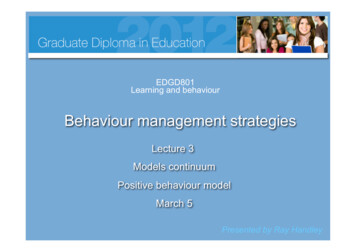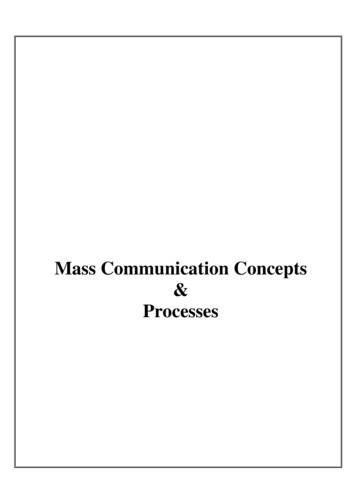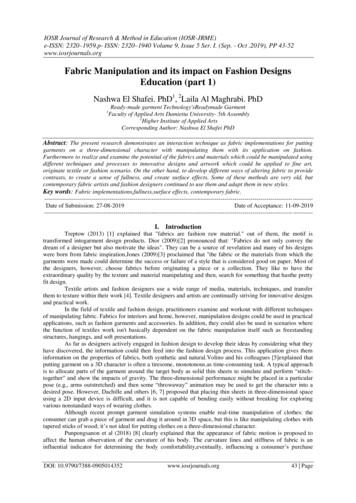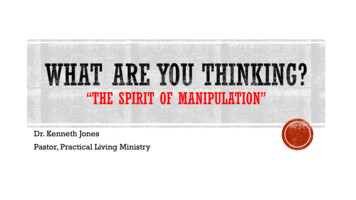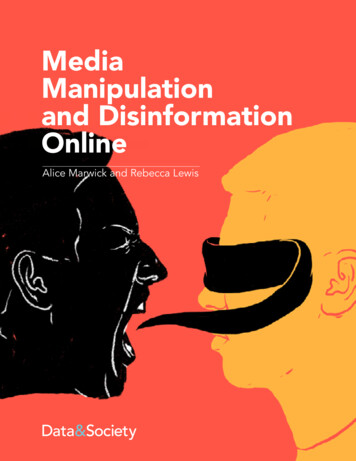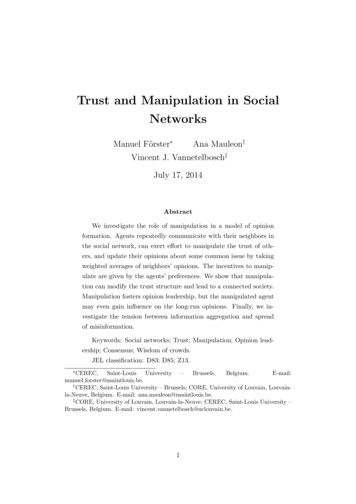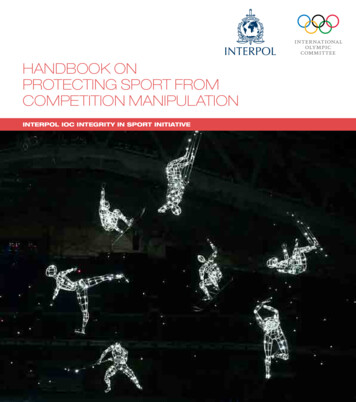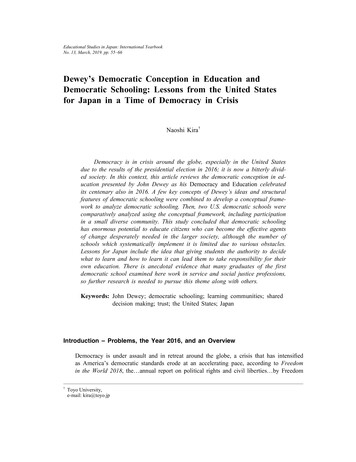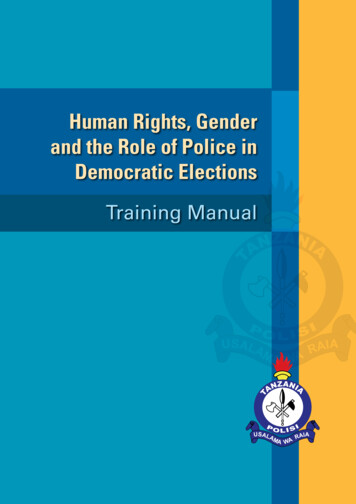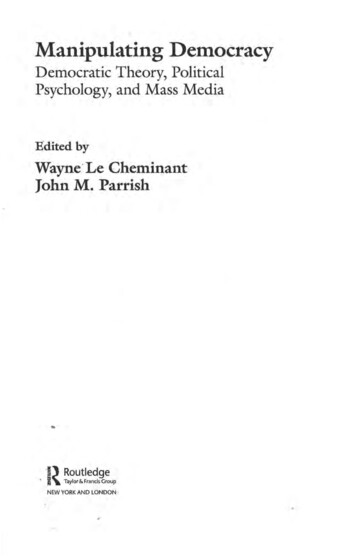
Transcription
Manipulating DemocracyDemocratic Theory, PoliticalPsychology, and Mass Media -E-d ited byWayne·Le CheminantJohn M. Parrish.' - o 1 n upNEW YORK AND LONDON
First published 2011by Routledge270 Madison venue, New York, NY 10016Simultaneously published in the UKby Routledge2 Park Square, Milton Park, Abingdon, Oxon 0Xl4 4RNRoutledge is an imprint of the Taylor & Francis Group, an informa busi1ws 2011 Taylor & FrancisThe right of the editors to be identified as the authors of the editorial material, and of theauthors for their individual chapters, has been asserted by them in accordance with sections77 and 78 of the Copyright, Designs, and Patents Act 1988.Typeset in Galliard by EvS Communication Networx, Inc.Printed and bound in the United States of America on acid-free paper by WalsworthPublishing Company, Marceline, MOAll rights rcsctved . 'o pnrt of this book may be reprinted or reproduced or. uti lised in 1\11 1form or by any dcctr(m.ic, mccb:lllical, or other n\ta.ns,.now k.now11 or hcrcnftcr invented,including phowcopying :uld recording, or in :my informru.ion srora.gc or rc!lricvnl syst·m,without permission in writing from the publishers.Trademark Notice: Product or corporate names may be trademarks or registered trademarks, and are used only for identification and explanation without intent to infringe.Library of Congress Cataloging in Publication DataManipulating democracy : democratic theory, political psychology, and mass media /[edited by] Wayne Le Cheminant and John Parrish.p. em.Includes index.[etc.]l. Manipulative behavior-Political aspects. 2. Political psychology. 3. Mass mediaPolitical aspects. 4. Democracy-Psychological aspects. I. Le Cheminant, Wayne.II. Parrish, John M.JA74.5.M353 2010320.01'9-dc222010009006ISBN 13: 978-0-415-87804-3 (hbk)ISBN 13: 978-0-415-87805-0 (pbk)ISBN 13: 978-0-203-85499-0 (ebk) lSUSTAINABLEFORESTRYINITIATIVE1Certified ibar Sourcingw.IW5fi ogram.o .1NSF-SFI-COC·C0004285TM!.IIIfiMIIIf'pJ WIIw.,t-t.
IlManipulation andDemocratic TheoryJames S. FishkinConsider some famous examples of political manipulation. I have chosen examples from other countries and times to give us the perspectiveof distance. Since manipulation .is a negative and contentious term, it isworth stepping back from current partisan divisions in order to clarify thephenomenon.In Britain, the 1924 Labour government of Ramsay Macdonald losesthe election in part because of the publication of a fake letttfr from theSoviet head of the Comintem, Grigory Zinoviev. The Conservatives winwith a red scare drum beatoffear that Labour is in league with the oviets,who were .in fact preaching continuous world revolution. In 1999, a British parliamentary inquiry opened up the historical issues, concluding thatofficials in tbe Foreign Office knew the letter was fake but were happy tosee the Lab ur government discredited right before the election.In the Australian election of2001, John Howa.rd and his government. falsely claimed that a boatload or"immigrams had thrown their childrenoverboard in order to try and seek asylum in Australia. Howard used thisto whip up anti-immigrant sentiment and pull ahead of Labour in the pollsjust before tbe election. A later Senate inquiry in Australia determinedthat the Howard government knew that the allegations were false.In Taiwan in March 2004, President Chen Shui-bian and Vice President Annette Lu were apparently the target of an assa.ssination attempton the eve of the election. A sympathy vote , llowed them to pu!J aheadby 29,000 votes. Later it seemed that the ass sination might have beenfuked. U so, ir would be another case of political manipulation.Add to these the more familiar cases of the '(Willie H rton" adsdeployed against Michael Dukakis in 1988 and the "Swift Boat Veteransfor Truth" ads deployed against John Ketry in 2004.orne of the Willie Horton ads and all the Swift Boat ads reflect the factthat campaign warfare is increasingly "asymmetrical." Just as States nowface non-state a tors where deterrence bre.1.ks down because the attack hasno dear return add1·ess (no one knows who the ter.rorists arc or how to.find them), sop litical campaigns face attacks from third parties tha alsohave no clear return address. The beneficiaries can keep thcir hands clean,
32 James S. Fishkinavoiding public responsibility for the attacks. And if a campaign dialogueis hijacked by a new dimension or a trivial one, the result is literally MAD,what I would call mutually assru·cd distraction.Consider a policy example outside the context of elections. Interestgroups now launch campaign -like advertising combined with lobbying.The coal ind stry has repeatedly mounted campaigns on behalf of taxsubsidies for so-called cle:u1 coal. The ads describe how much cleaner andhow much better for the environment clean coal is, never making it clearthat the tax subsidies could divert energy use away from much cleanersources . Glean coal may be cleaner than dirty coal, b\.tt it is much dirtierthan natural gas or renewable energy. Note in this c.ase the use of st ·ate gically incomplete rather than false informatioo. 1 On· successful wave ofthese efforts led to the Energy Policy Act of 2005, which included largetax subsidies for clean coal which the Bush administration implemented.We live in a society that values freedom of expression and associationas a matter of right. The system of freedom of expression presm11es thatmany forms of advoca y take place. What is the dividing line betweenmere advocacy and something that is presumably-objectionable (even iflawful) th,atmigbt- be, termed-manipulation? Stephen Ansolabehere andShanto Iyengar suggest a definition in the course of their -important study·o f negative advertising: "Manipud.ation involves leading voters to selectpoliticians who ultimat ·ly do not represent the individual's interests andpreferences. " 2This definition, while uggestive, does not cover all the terrain sketchedhere. First, 1 am interested in including efforts to manipulate voters, notonly about candidate choice but also about policy d1oice. Second to theextent independents are intentionally caused to change their behav.ior bystaying home or voting otherwise than they would, thi,\; definiti.o n, asinterpreted in Going Negative, would not term the intervention manipulation. As they operationalize their definition, voters have to have a stableparty preference (representing their interests and preferences) which theyare Jed· away from by the manipulation, and independents do not havesuch a preference. Even if they are led to change their vote by n gative ads(and 6 percent did in the study), this change was not viewed as manipulation since they had no stable party preference from which they weredissuaded. Instead Ansolabehere and Iyengar simply termed such results"worrisome" but not manipulation. 3In my view, all the cases mentioned are manipulation, including thecalculated effort to reduce turnout, a possible use of negative ads according to Ansolabehere and Iyengar. The definition I would suggest is something like:A person has been maniptt./.atcd by a communication when she hasbeen exposed to a message imertded to change her views in a way shewould not accept if she were to think about it on the basis of good
Manipulation and Democratic Theory33conditions-and in fact she does change her views in the manner thatwas intended,.So, if she is fooled by misinformation and changes her views on thatbasis, then she has been manipulated. If she had good information instead,then on this definition, her views would not have chang d.In the Zinoviev case, it is likely that the voters who were changed werenot Labour vOters, since there was widespread sympathy for the SovietUnion among Labour voters in the early years of the Soviet Union. Rather,it was most likely independent voters who were switched and Conservativevoters who were mobilized who might not have voted at all otherwise.In the Australian case where the Howard campaign claimed that theimmigrants threw their children overboard in order to gain admissionto the country, there was no problem of mobilization since Australia hascompulsory voting. But the sensational incident primed immigration asthe key issue when it had not beel1 a top issue at all before then in theelection. It changed the basis for voting If voters had known that thesensational charges were false and known to be false, this hijacking of anelection s0on before the vo\e through priming would not have succeeded.As one press rep0rt after the Senate inquiry summarized it, the Howardgovernment "exploited voters' fears of a wave of illegal immigrants bydemonising asyltrm-seekers."4In the case of Willie Horton, .the combustible focus group tested adsprimed crime and Dukakis's judgment as issues for decision , based on amisleading account of a single incident. In the case of the Swift Boats,false allegations primed Kerry's character as the issue. The Swift Boatcampaign may well have swung the election given how close it was.Ii1 the case of the clean coal ads, if citizens had the facts about thecompeting energy choices, they would be unlikely to support incentivesfor coal compared to natural gas and renewable energy. The apparent factsare strategically incomplete, laying out the advantages of so-called cleanover dirty coal, but not compared to the other alternatives.In the case of negative ads being used to intentionally demobilize voters, if I wouid have voted were it not for the negative ads intended to getme not to vote, my behavior has been changed in the direction intended.And I am assuming that if a voter deliberated, she would likely cast a voterather than just stay home. Or at least this would be the case in many elections where negative ads succeed in getting people to stay home. For thosecases, there are clear grounds for claiming manipulation on this view.In all these cases, the definition of manipulation turns in part on thealternative of good conditions and good information we are hypothesizing as a benchmark for comparison. Those good conditions are in fact, agood part of what I mean by deliberation, a process we attempt to implement empirically in the conduct of Deliberative Polling.By hypothesi zing what people would think under good conditions as
34 James S. Fishlzina point of compari on, we are not asser ing that whenever people arenot deliberating they are then being manipulated. Others must actuallyifttcnd to manipulate opinion in a given direction for the opinions to bem:arupulated. And the goo conditions defined by deliberation are just abendu:nark: for comparison- a way of clarifying what is short circuited bymanipulation. Perhaps maniptilators want nw to ·thinkX. l?crhaps I wouldin fact think X, ifl deliberated about the is ue (particularly if I consideredthe competing arguments and had good information about them). Onthe definition offered here, 1 have not been mani!Julated if that is the cast:and I do think X. sWe can think of deliberation and manipulation as poles n a continuum. At ·o ne end we have good conditions and at the other end we haveseverely dist rtt d conditions intentionaUy created in order to influeo.cebehavior: The good conditions include balanced messages with reason ably a.ccuntte information. Balance means that arguments offered areanswered in a substantive way by arguments reflecting a competing sideand those argui:nents are answered in turn and so on. An.d the information employed in these· mes ages is factual and accurate. When argumentsare offered and then answered substantively in tum, strategically incomplete arguments are defused. For example, a dean coal advocate couldtalk about how much better clean-coalis than dirty coal, but the case foradopting dean coal would have to fuce criticism from the advocates ofother cleaner somces. At the other end f the continuum, we have unbalanced and inaccurate messages. Arg ments offere'd are no answered. Andthe lack of substantive balance and the inaccuracies are intended to moveopinion in a given direction.What is the difference between manipulation and persuasion? In a society valuing free speech, we fill the ai ;wavcs with persuasion. Clearly, therewill be.areas on the continuwn whcrelt is hard to distinguish. But the endpoints make it clear. The messages in deliberation are intended to persuade,but in a dialogue or debate in whicl, accurate· information is available andin which it is expected that the other si.d e will have its say. Hence clearmisinformation or strategically incomplete arguments that would collapseif the other side were voic d would be avoided in deliberative prot::esses.At the other pole the knowing u.sc of such misinformation or misleadinginformation is the point of the message. P ;rhaps you have an overwhelming ad buy or perhaps you know the charges are o se.nsational they will.receive a massive hearing, drowning out any response. Persuasion is thelife blood of politics and policymaking. Manipul tion is its objectionablefonn. But from the standpoint of democratic theot;y, what,.if anythi.ng, iswrong with manipulation even in its supposedly objectionable form? Theanswer depends on your theory of democracy. On some theori,es, there areno grounds for objection. 13ut that only helps to clarify the deba e aboutwhat it is that we should ultimately value about democracy.
Manipulation and Democratic Theory35Four Democratic TheoriesTo distill a longer discussion down to its essentials, I want to reduce thevariety of democratic theories down to four. These four theories are distinctive combinations of four baliic princi pies-political equality, deliberation, mass participation, and non-tyranny. Elsewhere I have developedthis account in detail so I will try to just quickly summarize it here. 6 Ihave argued that while there are, in theory, sixteen possible combinationsof commitments to these four principles, the ones that have serious normative interest reduce to four: competitive democracy, elite deliberation,participatory democracy, and deliberative democracy.The four democratic theories each make an explicit commitment totwo of the principles and leave open what they say about the other two.Their position on. the other two can be taken as an empirical question: oras a question that they arc just not concerned about. I indicate their com"mitmertt to the pritJciples of central concern by a " " and their agnosticism about the other principles by a "?"(see Table 1.1).The four positions are prominent and l,"e !:ognizable. First considercompetitive democracy. Here the .idea popularized by Joseph Schumpeterand inore recently championed by Richard Pos.ner :Uld Ian Shapiro is thatdemocr cy is about the "competitive struggle for the people's vote." 7 Butlike many adversary processes 1 the key is Wi.!:!ning by whatever means iavailable within the mles. And the rules do little or nothing to preventthe public from being bamboozled, misled, or manipulated in the waysalready catalogued. I have adjusted the position slightly to commit it to political equality inthe equal counting ofvotes. Schwnpeter, unlike Ills successors, was notoriously unconcerned about equally cotmtit1g .t he votes of ev ryone. 8· T1Jebasic idea is that we let the parties compete as teams that will peacefnllysettle the question of who governs, and ·we allow courts to p ;otect rightsto ensure against tjrranny of the majority or other truly objectionableabuses. But if really intense competition produces manipulation, that isjust hc w the rough game of politic ·is played. Hard political competitionamong competing teams of elites has greatel.' normative appeal if the votesare counted equally. But the issues of extreme preference distortion, whatTable 1.1 Four Democratic TheoriesCompetitiveDemocracyPolitical equalityEliteDeliberation ParticipationDeliberativeDemocracy · DeliberationNon-tyrannyParticipatoryDemocracy
36james S. Fishkinwe have been calling manipulation, are a continuing vulnerability of theposition.,A second democratic theory, by contrast, prizes deliberatioq-butonly by elites or representatives: Deliberation requires the balanced andinformed weighing of competing arguments on their merits on the basisof good information. We will say more about this below, but, clearly, thedeficiencies that permit manipulation are, by and large, responded to bydeliberation. Note that the elite deliberation position does not requirepolitical equality. It is deliberation by elites-as with the Madisonian picture of filtered public opinion by representatives who "refine and enlargethe public views" as Madison posited famously in Federalist 10. It is nota position that encourages mass participation. Once again, there is a concern for protecting again t tyranny of the majority, but an argument thatdeliberation itself may qetter s rve the public interest than, would nondeliberative public opiqion:A third democratic theory prizes the combination of mass participation and political equality. One can imagine more and more decisionsbecoming the purview of plebiscitary democracy or rriass decision. Butas I argue elsewhere it is very difficult to foster serious mass public deliberation. Each individual in the large scale nation state has incentives for"rational ignorance" and, in.that sense, little reason to pay attention andbecome informed about the details of public policy issues. Participatoryqemoc.racy may signal a certain kind of mass consent, typified by a referendum, but it need not be a very thoughtful or informed sort of consent.Referendum campaigns can be as misleading and bamboozling as candidate elections, as most observers of initiative, referendum, and recall inthe western U.S. states will attest.A fourth democratic theory would embrace the combination of deliberation and political equality. The idea is that the mass public shouldsomehow deliberate and its deliberations should be made consequentialfor public decisions. One clear strategy for achieving this combination ofpolitical equality and deliberation is the deliberative microcosm chosen bylot or random sampling-a form of democracy that ·goes back to ancientAthens. Every citizen has an equal chance of being selected and the processes themselves attempt to embody political equality. But in addition,the discussions attempt to be substantive and balanced on the basis ofgood information. As we have seen, the provision of substantive and balanced information, in a context where people pay .attention tq it, can bean antidote to manipulation.Facilitating 't he Public WillOne reason to argue for one of the two deliberative theories (elite deliberation or deliberative democracy) is that without some such commitment there are no really fundam ntal grounds for objecting to the kind of
IManipulation and Democratic Theory37marupulation We surveyed at the beginning, the kind that clearly W1dcrmines any claim to collective informed consent. Wh, t could consent ofthe governed mean if the people are simply misled? Panicipatory democracy and camp titive dcm a:acy do not deal with the issue of p,reterenceformation; they deal with bow people vote r participate with the pJ:eferences they have. Qnce the issue of preference formation is highlighted,then there are grounds to.r demanding that people get good information,have. a cess to arguments on competing ·ides, . and have the chance toweigh the merits of iliose arguments-in short, that they deliberate tosome substantial degree.If 0ne believes that public will formation is potentially p1eaningful,then manipulation is objectionable, because it is intended to undermil'leand distort the public wiU for the sake of political advantage. By conttast,deliberadon is to be prized on such a perspective becau e it facilitates public will fdr 1ation. lt facjli testhe provision of competing reasons that areto be weighed in the process of the people making up its mind.Yet t:Qe deliberadve microcosm chosen by raJ1dom san1pliJ1g, broughtto realization in the modern era with efforts s tch as Deliberative Polling,is not necessarily efficacious in undermining manipulation. A key probtcmis that manipu:lati n may work wiili the broader public even if it. encounters an antidote in the deliberations of a microcosm.One strategy is to make the deliberations of the microcos nse quential in themse.lves. In tha way, deliberation by the microcosm, ratherthan manipu lation of the bro der public, is consequential in its impact. InTexas, a series o Delibcrative Polls were employed in "Integrated.ResourcePlano ing" to decide how electric ower was to b.e provided in each of thestate's eight regulated service territories. The deliberations were bala.nccdand informative. fhc real benefits of coal, availability and pr!ce, werew ighed aga,ins environmental effecrn. The meaning of clean coal cameout in the d.iscussion since advocat of all d1e competing energy ourcesanswered guestions on the sarne p ncl. While support for coal was modestin most Of the eight projects support for renewable energy and for naturalgas (which is dcam:r than coa l). was consistently high. The eight projectsled directly to massive investments in wind power, moving Texas fro m oneof the I west states in wind power in 1996 to the kading state by 2007.The key in 'IC:xas was tha the rnicrocosm was empowered to the extentthat the official integrated resource plans had to take accountofthercSllltsof rbe Deliberative PolL lt.is not at aJJ clear what the results mjght havebeen if the issue had been decided simply in open meetings or by referendum.Jn open meetings elf-selected group. of lobbyists or advocatescould have ;listortcd the pl'ocess. In a referendum c lqlpaign subject toadvertising techniques, manipulation of the res.u1ts would certainly havebeen pos 'ible. But in the transparently balanced and substantive atmo sphere of a: microcosmic deliberation, the strategies of tni!iinformation orstratcgkally incomplete infi· rmation can be countered among those who
38James S. Fishkindecide. And a microcosm of the mass public will tend to come with anopen mind and be available to weigh arguments on the merits.The basic idea of a deliberating microcosm is not, by itself, enough to"avoid manipulation. Random sampling is extremely useful to prevent captu rc by self-selected roups that cou.ld mobilize to d istott andin that senseoffer a p cudo-public c nsultation. Norman Bradbum, former director o the National Opinion Research Center, has coined the term SLOPs forself-selected listener. opinion polls, and there arc many publi,c consultations, especially those that take. place online, that purport to representthe public but that actually rcpresen efforts to capture a representationof public opinion through mobi lization. SLOPs allow people to vote overand over and to offer their intense views as if they were, representative ofthe br adcr mass public. Random sampling eugage·s social scien to prevent capture and create a microcosm. Of course·then, the question is what'arc the good conditions to which the microcosm i.s subjected.A second guarantee against manipulation is· the avoidance offulse c risensus rhxough social pressure. J ublic consultations that seek agteement,in th mode of jur r verdicts, wi ll el(pO e particiPf!nts to social pressure toreach agreement. It is a far better guara utce to avoid consensus-seekingprocesses and to gather the pinions, before and afte(l, in corifi.dentialquestionnaires or secret ballots.'A third institution ! design tha.t can help avoid manipulation is toarrange for an advisory committee fox the pr cess that includes the competing stakeholders. If policy elites have to agree on an account of themitial basis for d iscussiou, the competing arguments that most deserve. ahearing on the basis of good infomtation, then they lose their opportttnity to distort the process with misinformation or strategically incompleteinformation. In Deliberative Poll , an advisory group typically involvesall the competing stakeholders who haye to agree on a briefing doc uTment suitable for the mass public. This briding document hws out themain policy options with arguments for and again"st, agreed to by thecompeting stakeholders and experts. They need ·not (and will not) agreeabout what·should be done. But they can agree that the information inthe briefing document is accurate and that the main arguments on eitherside have been expressed clearly and in a balanced way. The }VOrk fromsuch an advisory group is a useful and simple institutional bulwark againstmanipulation of the microcosm.A fourth institutional design is the use of moderated small group qiscussions that ensure balance and that prevent anyone from dominatingthe discussions. The key nexus for deliberation is a manageably smallgroup discussion that allows balanced participation in an atmosphere ofmutual respect. Trained moderators can-do a great d l to facilitate suchdiscussions.But even with an appropriate institutional d.esign that avoids manipulation of the microcosm, manipulation of the broader mass public is entirely
Manipulation and Democratic Theory39possible through the normal investments in trategic communicationthrough the media. Even here, deliberating micro osms can be , useful,however. A Ueliberative Poll, for example, can offer a road map to respon sible advocacy. y responsible advocacy, I mean advocacy based on goodinformation and balanced argumentation. In a Deliberative Poll, whenconducted well, the best arguments on each side have been tested againsteach other in a ontext where the public can get its questions answeredand focus on the merits. The arguments that succeed in such an environment clearly have weight with the public if given an appropriate airing.Retracing tha argumentation with good information is not manipulation, because lt reproduces the considerations that weigh with the publicunder good conditions.For example, in the European-wide Deliberative Poll, the contentiousissue of pension reform revealed su.rprisingly that the EU public was willing to work longer· and raise the ret.iremeJ t age in order to keep the current "pay as you go", pension systems solvent.9 Once they realized thed mographic and fiscal challenges ahead, the changing ratio of retirees· compared to workers and the result1ng deficits facing the pension systemsif the curren retirement ages and benefits were kept in place, deliberatorsmoved to suppollt keeping the benefits but paying for them by working toa later age. They prefwed this solution to privatizing the systems, probably because of the risks involved in individual accounts. These resultssuggest a strategy for successfoJ advocacy of how to keep the pay as yougo stems solvent but with a dear sacrifice (later retirement) as part ofthe trade-off. The demographic and fiscal information about what wouldhappen \Vitb continuation of the status qu is a necessary backdrop to thes.uccess of the argument.Democratic practicf\5 have largely traceq a path from Madi:son (whoconceived of adapting the public will to a Republic in the late eighteenthcentur::y) to Madison Avenue (the hom of the advertising industry) . But·there is a crucial d.istinction between manipulative practices of persuasion,which we tolerate tor: selling consumer products, and the sort of collectivepublic wi1'1 formation that make democracy meaningful Some democratictheories do not asp we to collective will formation. In our typology of foUItheories, only. two mak the thinking processes' of the public central. Thetw.o deli er;1tive theories (whether the deliberations of representatives onbehalf of the people or the deliberations by the people themselves) provideat least a partial antidote to manipulation. For the other two theories,there is no fundamental basis for objecting ,to manipulation. For thosetheories, the key is just that there be elections, no matter J1ow distorted in substance, or that there· be participation , no matter what the· people. are thip.ki g, or not thinking. If one wishes to revise participatory orcompetitive democracy to take account of manipulation, one enters therealm of at least some commitment to deliberation, ·orne commitmenr to, the notion that the people not be misled or have their view deteFmined
40 James S. Fishkinon grounds other than those they would think defensible if they thought'about it. Avoiding manipulation, one is led to deliberation-to at leastsome degree and in some institutional contexts by or on behalf of thepeople. The cure for Madison Avenue is a dose of Madison, or at least thevalue Madison emphasized but thought most suitable for representatives.Notesl. ec Ricbard Conniff, "The Myth of Clean Coal," Yale 360 at http://e360.Y.alc.cdu/content/feature.msp?id 2014'2. Stephen Ausolabehcre and Shanto Iyengar, Going Negative (New York: FreePress, 1995), p. 65.3. Ansolabeherc and Iyengar, Going Nt;gativt;, p. 95.4. Kim Arlington, ":Hawke: Child cn Overboard the Mosr Despicable ofLies."Mel!Jot,smc Age, Augus 24, 2004, http://www.thcabre.c o m .au/articlcs/2004/08/24/109324652043l.html?from, starylhs.5. M tnipulatior l is sometimes used more broadly, but I am focusing here on itsobjectionable forms. 6. ee my Whm the People Spcit}t: Deliberative Dtmtocracy a,l.d PJtblw ConmltatiotJ (Oxford: xford University Press, 2009).7. Joseph A. Schumperer, Cafiitalism) Socialism awf Democra.r.y (New Ycwk:Harper and Row, 1942); Richard A. Posner, Law, Pragmatism tmd Det :Joc rac,y ( ambridge, MA: Harvard University Press, 2003), p. 269; and Jan'. Shapiro The Moral Hmt datiom o[Po!itics (New HaYen, CT: YaJe UniversityPress, 2002).8. See 'Robert A. Dahl, Demom ocy rmd its Ct·iti.cs (New Haven, T: Yak University Press, 1989), pp. 121-22 for a critique ofSchumpercr on the issue afinclusion.9. See http://cdd.stanford.edu/pollsjeu.
l Manipulation and Democratic Theory James S. Fishkin Consider some famous examples of political manipulation. I have cho sen examples from other countries and times to give us the perspective of distance. Since manipulation .is a negative and contentious term, it is worth stepping bac
